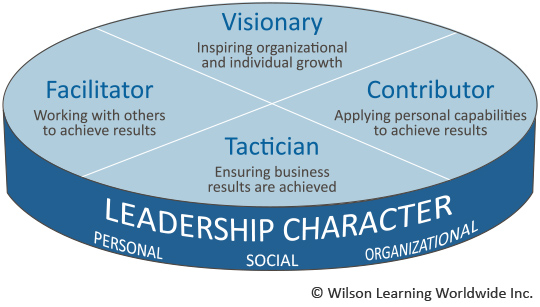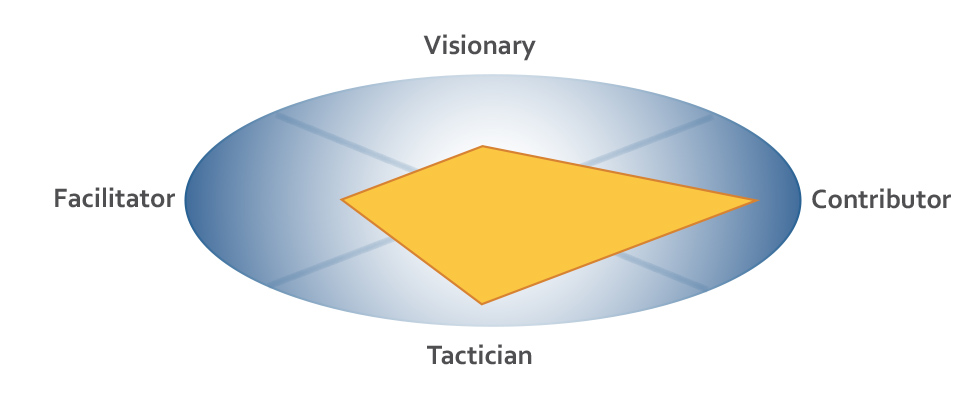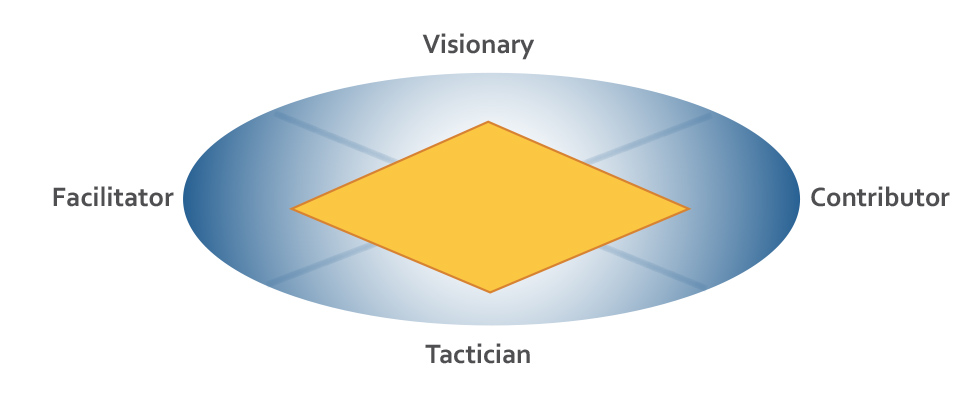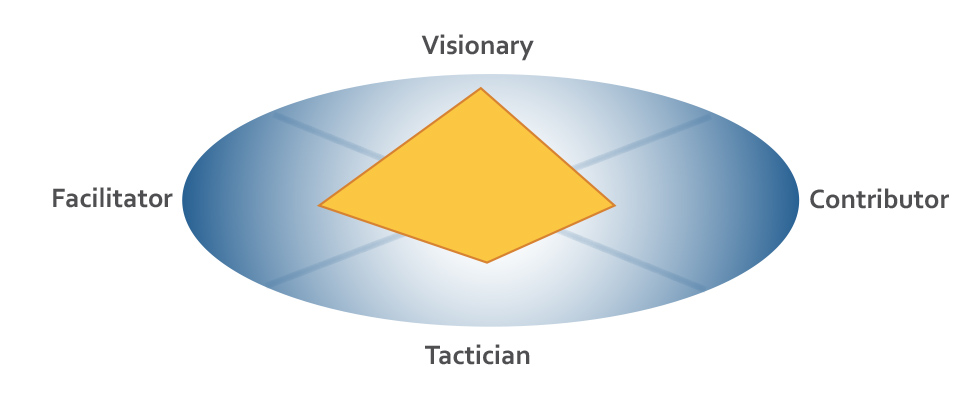Le modèle de compétences en leadership
Quelles sont les compétences nécessaires pour un leadership efficace (extrait d’article de journal)

In the 50 years that Wilson Learning has studied leadership and has helped its clients develop their approaches to leadership, we have come to believe that how leaders view their purpose will set the course for their organisation’s success. Wilson Learning’s paper “Developing Great Leaders: Integrating Leadership Character and Skills” presents our point of view that effective leadership is a balance of values-driven character (Essence) and skills and competencies (Form). In this paper, we review the specific integration of both Essence and Form.
Integrated Leadership: The Balance of Essence and Form
Wilson Learning’s approach to assessing and developing leaders was created with the intent of tapping both the Essence and Form of leadership. Essence is captured in what we call Leadership Character—those elements of leadership that are core to how people view the purpose of leadership. Form represents the skills and knowledge needed to take action on these Leadership Character elements. While distinct, both aspects are critical to effective leadership.
Leadership Character: The Essence of Leadership
Leadership Character is comprised of values, characteristics, and clarity of purpose that determines what one wants to be as a leader. It is expressed in the consistency of behaviour—the degree to which a leader’s actions match his or her words.
| Key Aspects of Leadership Character | ||
| Personal Character | Social Character | Organisational Character |
|---|---|---|
| Staying steadfast and decisive in the face of adversity | Showing others respect, being compassionate, and valuing individual differences | Willingness to put organisation and customer needs ahead of personal needs |
|
|
|
Our research has identified 18 individual Character factors that have been linked to leadership success. Wilson Learning categorises these into three principal components: Personal Character, Social Character, and Organisational Character. Effective leaders demonstrate a balance of all three components as core values. Leadership Character is expressed differently in different leadership positions, but is always a critical element of effective leadership.
Form: The Four Roles of Leadership
While Leadership Character is the foundation of effective leadership, it alone is not sufficient. Unless this foundation is supplemented by the skills and knowledge required to execute on those values and principles, the leader fails to produce the tangible results necessary for creating organisational success.
Based on both in-depth research and practical experience, we have found there are a number of skills required to execute effective leadership. These skills, which comprise the Form aspect of leadership, can be organised into four core roles that each leader must fulfil:
Wilson Learning’s Integrated Leadership Model

- The Visionary role focuses on setting direction by translating strategy into work group requirements.
- The Tactician role ensures activity toward that vision, achieving results by effectively planning work, delegating responsibility, and reviewing performance.
- The Facilitator role makes sure everyone is appropriately involved, creating an environment of collaboration and partnership to ensure effective working relationships.
- The Contributor role ensures the leader’s own talents, experiences, and abilities are being applied to create organisational success.
These four roles define the seemingly contradictory responsibilities of a leader—often considered the greatest challenge of leadership. Being a great leader means being able to effectively balance these four roles and successfully integrate them with Leadership Character.
Profiles of Leadership
All leaders, regardless of level, need to fulfil all four roles. But the relative importance of each role will vary, depending on the specific responsibilities of that leader. As described in “Understanding Leadership Development: Integrating Essence and Form,” most organisations develop leaders based upon three common levels:
- First-level leaders—Managers and supervisors of individual contributors
- Mid-level leaders—Managers of departments or functions, managers of managers
- Executive leaders—Executives responsible for the overall leadership and culture of the organisation
 First-Level Leadership
First-Level Leadership
First-level leaders are often making a difficult transition from being an individual contributor responsible only for their own performance to being a leader who adds value by getting work done through others.
| First-Level Leadership Competencies | |||
| Visionary | Tactician | Facilitator | Contributor |
|---|---|---|---|
| Understanding and translating strategy into work group requirements | Ensuring results are achieved by effectively planning work, delegating responsibility, and reviewing performance | Creating an environment of collaboration and partnership to ensure effective working relationships | Creating organisational success by contributing their personal talents, experiences, and abilities |
| KEY FIRST-LEVEL COMPETENCIES | |||
|
|
|
|
To accomplish this transition—and ensure sustained success—a new first-level leader must quickly acquire the necessary Leadership Survival Skills. These survival skills are primarily found in the Tactician and Contributor roles, given the first-level leader’s responsibility for ensuring tasks are completed and objectives met. This requires the first-level leader to ensure all employees are adding value, while also making decisions that are in the work group’s best interests. While these leaders will need to effectively translate organisational strategy into day-to-day work group objectives—and will occasionally have to lead team efforts—most of their time is spent on the tactical aspects of “getting the job done.”
While these survival skills occupy much of the development focus, these first-level leaders are also going through an Essence transformation. A first-level leader needs to establish what he/she wants to be as a leader—what we call Establishing Leadership Credibility. First-level leaders must understand how their character affects the performance of their work group in order to successfully transition their source of credibility from technical expertise to leadership.

| Mid-Level Leadership Competencies | |||
| Visionary | Tactician | Facilitator | Contributor |
|---|---|---|---|
| Understanding and translating strategy into work group requirements | Ensuring results are achieved by effectively planning work, delegating responsibility, and reviewing performance | Creating an environment of collaboration and partnership to ensure effective working relationships | Creating organisational success by contributing their personal talents, experiences, and abilities |
| KEY MID-LEVEL COMPETENCIES | |||
|
|
|
|
Mid-Level Leadership
As leaders move into mid-level leadership, their focus shifts from one-to-one survival skills to more one-to-group development skills. This focus on what we call Growth Skills means mid-level leaders require moderate to strong skills in all four leadership roles. Mid-level leaders are expected to execute on strategy, even though they may not have been involved in the actual formation of that strategy. They often need to work with and influence peers over whom they have no authority and confront interpersonal conflict within the organisation. Mid-level leaders also require strong tactical skills as they manage other managers in accomplishing group objectives. They are also often called upon to contribute their unique talents to solving functionally specific problems or making critical decisions. Without a doubt, mid-level leaders wear many hats.
The role of Essence also grows in mid-level leadership. While mid-level leaders do need to add to the foundational skills developed as first-level leaders, their need for character development (Essence) expands significantly. If the Essence transition for first-level leaders is to Establish Leadership Credibility, the Essence transition for mid-level leaders is to become a Purpose- and Values-Centred Leader.
When mid-level leaders develop Purpose- and Value-Centred Leadership Essence, depth of character becomes more important than appearance of power. They take action based on values, not on short-term gains. Success is measured by their contributions to others, not title or salary. And life is lived on purpose, not on approval from others.
 Executive Leadership
Executive Leadership
As leaders reach the executive level, the need for additional skills shifts more toward organisation-level strategic skills. The primary roles of the executive leader are Visionary and Facilitator, as these leaders are expected to drive change, create a vision for the organisation’s future, and develop strategies for achieving that vision. To accomplish this, executive leaders need strong Facilitator skills to get diverse functions and employee groups working together toward a shared positive future.
| Executive Leadership Competencies | |||
| Visionary | Tactician | Facilitator | Contributor |
|---|---|---|---|
| Understanding and translating strategy into work group requirements | Ensuring results are achieved by effectively planning work, delegating responsibility, and reviewing performance | Creating an environment of collaboration and partnership to ensure effective working relationships | Creating organisational success by contributing their personal talents, experiences, and abilities |
| KEY MID-LEVEL COMPETENCIES | |||
|
|
|
|
The Tactician skills inherent to this level are usually limited to supporting functional managers’ tactical leadership efforts, whereas Contributor skills are typically reserved for more critical situations. Executive-level leaders who spend a lot of time in Tactician and Contributor roles are not viewed as being effective because they clearly have not sufficiently developed their next line of managers.
As one would expect, the core of effective executive leadership is Essence. We refer to this as Culture-Centred Leadership because the responsibilities shift to elements that shape organisational culture—the consistency of communication and action, integrity and transparency, and being the example for other leaders and employees to follow.
Integration of Essence and Form
In the end, effective leadership is about integrating Essence and Form—clarity of purpose for what one wants to be as a leader, and the ability to execute the roles of the Visionary, the Tactician, the Facilitator, and the Contributor. Only through this integration of Essence and Form can a leader effectively create the conditions for achieving performance with fulfilment and engage others in fully committing their energy, creativity, and talents. Today’s business climate requires leaders who are role models for this integration—leaders who express an excitement about the possibilities of leadership. To them, leadership is being of service to others. And despite the many challenges they face, effective leaders exude a profound energy, a contagious excitement, and an undying hope about the future that is inspiring to everyone around them.
So, what can you do to help your leaders successfully integrate Essence and Form? It begins by understanding the key challenges facing your leaders at each level of the organisation. From there, identify the key competencies needed to address these challenges, and take the time to carefully assess skill gaps—in other words, how do your leaders’ current skill levels compare to what they need in order to be fully successful in their roles? With this understanding in place, your focus can then shift to identifying the best development strategies for closing those gaps, helping your leaders create the conditions for organisational success.
Pour en savoir plus, contactez Wilson Learning au 01 47 51 70 70 or rendez-vous sur notre site Internet at WilsonLearning.com.







 Merci de remplir ce formulaire afin de télécharger Le modèle de compétences en leadership | Quelles sont les compétences nécessaires pour un leadership efficace (extrait d’article de journal)».
Merci de remplir ce formulaire afin de télécharger Le modèle de compétences en leadership | Quelles sont les compétences nécessaires pour un leadership efficace (extrait d’article de journal)».



